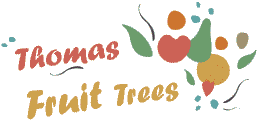Roberts Crab apple trees
(Robert's Crab, Robert's Red)
Malus domestica - Picking season: Mid
- Self-fertility: Self-fertile
- Flowering group: 2
Roberts Crab is an unusual crab-apple, grown both for its attractive ornamental qualities, and for culinary uses.
The abundant spring blossom is dark pink, and the leaves have a bronze tint.
Ripening in late summer, the crab-apples have an unusual dark purple colour. They are also very large - the size of small apples.
The main attraction in the kitchen is that the purple fruits have a rich red flesh, making Roberts Crab an excellent variety for crab-apple jams and jellies.
The red flesh also contains anthocynanin compounds, which may have healthy anti-oxidant qualities. A 2009 study by researchers at USDA found Roberts Crab to have particularly high levels of Cyanidin-3-0-galactoside.
The juice is a dark red claret colour, which is darker than that of other red-fleshed crab-apples. The juice flavour is sharp and crab-like, and can be used in cider blends.
Roberts Crab organic apple trees for sale
Next deliveries: December 2025
11 yeartree on M9 rootstock28.00€Small tree
(1.5m-2.5m after 10 years)
Bare-root 21 yeartree on M116 rootstock29.25€Medium tree
(2m-3.5m after 10 years)
Bare-root 31 yeartree on MM111 rootstock28.00€Large tree
(3m-5m after 10 years)
Bare-root
Sold-out
41 yeartree on Bittenfelder rootstock28.00€Very large tree
(5m-6m+ after 10 years)
Bare-root
EU delivery countries Click here to view estimated delivery charges
Click here to view estimated delivery charges.
Growing and Training
Roberts Crab seems to be self-fertile, but we do not think the purple blossom is compatible for pollinating other apple trees.
Roberts Crab is very precocious, and is likely to flower and fruit the first season after planting. We recommend you remove any fruitlets as soon as they form, for the first few years, in order to allow the tree to grow properly.
The tree grows with an attractive upright spreading form and is reasonably vigorous.
Roberts Crab characteristics
- Attractive featuresAttractive flowersAttractive fruit
- Gardening skillBeginner
- Self-fertilitySelf-fertile
- Flowering group2
- Picking periodearly September
- Picking seasonMid
- Season of use2-3 weeks
- Food usesCulinaryJuiceHard cider
- Country of originUnited Kingdom
- Period of origin1950 - 1999
- Flower colourPink - dark
- Flesh colourPink / Red
- Fruit colourPurple
Similar varieties
Early Red MeatEarly Red Meat is an early season apple with a marbled red / pink flesh. It produces a dark pink apple juice.
Pink PearlPink Pearl features bright pink flesh, and pink apple blossom.
Red DevilRed Devil is a versatile English eating apple, and produces a sweet red-tinted juice.
More about apple trees
While the vast majority of apples have white or cream-coloured flesh, some varieties have red flesh. Those with the most intense red flesh are usually descended from a red-fleshed crab-apple called Malus niedzetzkyana found in central Asia. The red colouration in this species also extends to the blossom, leaves and young shoots.
Other varieties feature pink flesh or pink / marbled flesh, and these are often more palatable.
The juice of red-fleshed apples is usually light or dark pink, and makes an attractive alternative to regular apple juice.
These varieties are of interest because of their ornamental qualities, and also because the anthocyanin compounds which give the flesh its colour are thought to have anti-oxidant properties.
